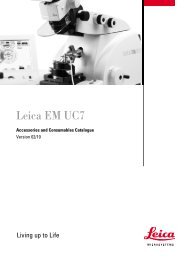Physical Principles of Electron Microscopy: An Introduction to TEM ...
Physical Principles of Electron Microscopy: An Introduction to TEM ...
Physical Principles of Electron Microscopy: An Introduction to TEM ...
You also want an ePaper? Increase the reach of your titles
YUMPU automatically turns print PDFs into web optimized ePapers that Google loves.
78 Chapter 3<br />
The major advantage <strong>of</strong> a <strong>to</strong>p-entry design is that the loading arm is<br />
disengaged after the specimen is loaded, so the specimen holder is less liable<br />
<strong>to</strong> pick up vibrations from the <strong>TEM</strong> environment. In addition, its axially<br />
symmetric design tends <strong>to</strong> ensure that any thermal expansion occurs radially<br />
about the optic axis and therefore becomes small close <strong>to</strong> the axis. However,<br />
it is more difficult <strong>to</strong> provide tilting, heating, or cooling <strong>of</strong> the specimen.<br />
Although such facilities have all been implemented in <strong>to</strong>p-entry stages, they<br />
require elaborate precision engineering, making the holder fragile and<br />
expensive. Because the specimen is held at the bot<strong>to</strong>m <strong>of</strong> its holder, it is<br />
difficult <strong>to</strong> collect more than a small fraction <strong>of</strong> the x-rays that are generated<br />
by the transmitted beam and emitted in the upward direction, making this<br />
design less attractive for high-sensitivity elemental analysis (see Chapter 6).<br />
3.5 <strong>TEM</strong> Imaging System<br />
The imaging lenses <strong>of</strong> a <strong>TEM</strong> produce a magnified image or an electrondiffraction<br />
pattern <strong>of</strong> the specimen on a viewing screen or camera system.<br />
The spatial resolution <strong>of</strong> the image is largely dependent on the quality and<br />
design <strong>of</strong> these lenses, especially on the first imaging lens: the objective.<br />
Objective lens<br />
As in the case <strong>of</strong> a light-optical microscope, the lens closest <strong>to</strong> the specimen<br />
is called the objective. It is a strong lens, with a small focal length; because<br />
<strong>of</strong> its high excitation current, the objective must be cooled with temperaturecontrolled<br />
water, thereby minimizing image drift that could result from<br />
thermal expansion <strong>of</strong> the specimen stage. Because focusing power depends<br />
on lens excitation, the current for the objective lens must be highly<br />
stabilized, using negative feedback within its dc power supply. The power<br />
supply must be able <strong>to</strong> deliver substantially different lens currents, in order<br />
<strong>to</strong> retain the same focal length for different electron-accelerating voltages.<br />
The <strong>TEM</strong> also has fine controls that enable the opera<strong>to</strong>r <strong>to</strong> make small<br />
fractional adjustments <strong>to</strong> the objective current, <strong>to</strong> allow the specimen image<br />
<strong>to</strong> be accurately focused on the viewing screen.<br />
The objective produces a magnified real image <strong>of</strong> the specimen (M � 50<br />
<strong>to</strong> 100) at a distance v � 10 cm below the center <strong>of</strong> the lens. Because <strong>of</strong> the<br />
small value <strong>of</strong> f , Eq. (2.2) indicates that the object distance u is only slightly<br />
greater than the focal length, so the specimen is usually located within the<br />
pre-field <strong>of</strong> the lens (that part <strong>of</strong> the focusing field that acts on the electron<br />
before it reaches the center <strong>of</strong> the lens). By analogy with a light microscope,<br />
the objective is therefore referred <strong>to</strong> as an immersion lens.



